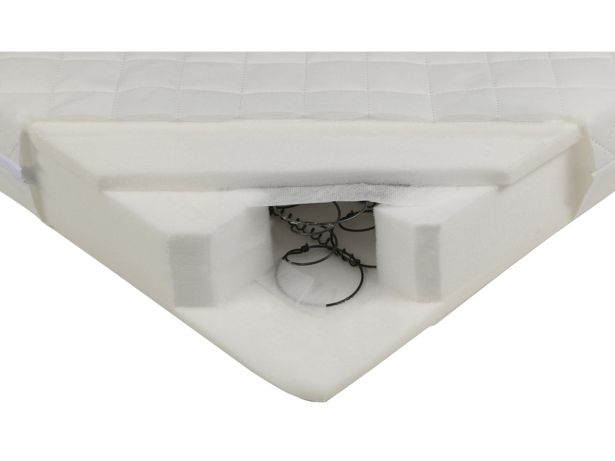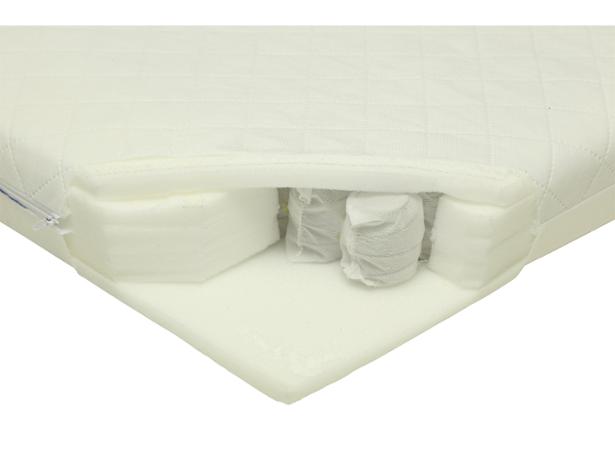How we test cot mattresses

In this article
- What are Which? Best Buys, Don't Buys, and Great Value cot mattresses?
- Cot mattress safety standards
- How well does the mattress support my baby?
- Is the cot mattress firm enough?
- How durable is it?
- How well does the mattress move moisture away from your baby?
- Does the mattress have good airflow?
- How easy will it be to clean?
Babies sleep a lot. This means your cot mattress is going to be one of the most-used items you're buying for your newborn.
Your baby will also grow quickly, which means a cot mattress needs to cope with the changing weight bearing down on it. And there are going to be plenty of little accidents coming its way as well.
You want to make sure that your baby’s cot mattress will stand the test of time. We put all the mattresses we review through a variety of tests that simulate two to three years of use, meaning you can have the confidence that your cot mattress will hold up.
Our cot mattress test is designed and informed by our years of testing experience. We buy all the mattresses we test ourselves, so you can be sure that the reviews you read are entirely independent and unbiased.
Our reviews seek to answer the key questions you'll want answered, such as:
Find out which mattresses keep your baby supported in our cot mattress reviews.
What are Which? Best Buys, Don't Buys, and Great Value cot mattresses?

Best Buys
The cot mattresses that impress the most in our tests are made Best Buys. A cot mattress needs to earn 70% in our tests to become a Best Buy, but you should still read our reviews to check for any factors that might impact your buying decision.
Don't Buys
Cot mattresses that receive a poor score of 45% or lower are Don't Buys and should be avoided - these are likely to have safety issues that could be dangerous for your baby or toddler. A cot mattress is automatically downgraded to a 0% Don’t Buy if our tests highlight a serious safety risk.
Our cot mattress reviews are for Which? members, but any mattresses labelled 0% Don't Buys are given a safety alert that's free for anyone to read, as we believe it's our public duty to inform all parents about any serious hazards or risks that our tests have uncovered.
Great Value cot mattresses
Great Value models do pretty well in our tests - they need to score at least 60% or more and achieve at least a three star rating for safety, as well as be tested to the latest version of the cot mattress standard that was released in 2021.
They're also at least 20% cheaper than the average cost of other cot mattresses in our tests. These are models highlighted by our experts to go for if you're looking for a bargain. Some Great Value cot mattresses also score well enough to be a Best Buy.

Cot mattress safety standards
Our safety tests replicate those in the current cot mattress safety standard, which is called BS EN 16890:2017.
It was approved in September 2017 and it’s a voluntary standard, which means that it’s not a requirement. However, manufacturers are strongly encouraged to meet these standards to minimise risks and hazards for babies and young children.
The standard tests include checking for choking and swallowing hazards, such as loose zip pulls and stickers, as well as entrapment and suffocation risks.
In 2021 the standard was amended to BS EN 16890:2017 + A1:2021, and we updated our testing to be in line with the new version of the standard.
Find out more about safety in our cot mattress and baby bedding safety guide
How well does the mattress support my baby?

The dummies show us whether the cot mattress sags once weight is placed on it, or if keeps your child's body totally supported.
A supportive mattress will help to keep your baby settled while sleeping.
Is the cot mattress firm enough?

One of our tests investigates whether a mattress is firm enough to help prevent your baby from being smothered when they roll over on to their face while sleeping.
If the top layers of the mattress are too soft and your baby accidentally rolls on to their front, their face could sink into the mattress, which poses a suffocation risk.
It’s a concern with babies aged between four and 12 weeks, when they are typically able to roll over from their back to their front.
Rolling from front to back requires more strength, and in some cases a baby may not master this skill until they reach around six months old.
As well as sleeping on the cot mattress, your baby will also be bouncing on it and playing on it as he or she grows, and that's not to mention all the times you'll be sitting on it while reading bedtime stories. You want to make sure that through all this wear and tear, the mattress you choose is going to stay firm.
How durable is it?
Our tests put each cot mattress through the equivalent of roughly four to six years' use. This involves repeatedly hitting the mattress with a weight, to replicate your toddler jumping or sitting on it every day. We then record any changes to the mattress, including damage.
A good mattress will be able to withstand our durability test and retain its firmness throughout. It should also not lose any of its height. This ensures that the mattress will remain safe and supportive for your child all the way up until they move on to a junior bed.
How well does the mattress move moisture away from your baby?
The truth is that your cot mattress is going to be subjected to a lot of liquids. Babies get sick, their nappies leak, and numerous spills are inevitable.
It's important that your baby doesn’t sleep on a damp cot mattress, and we need cot mattresses to move moisture away from them.
We test each cot mattress to see how easily moisture moves away from the outer layers. We've found that some are very good at doing this, while others allow liquids to sit on the surface.
Does the mattress have good airflow?
We use special equipment to check the airflow through the mattress.
This is to assess how breathable it is, as it’s important for fresh air to circulate around your baby’s face.
It’s also to see whether the mattress draws away body warmth effectively so your baby doesn’t overheat.
How easy will it be to clean?
You will probably probably need to start cleaning your cot mattress from the get-go.
If it comes with a removable cover, we'll check how easy this is to get on and off. You don’t want to be battling with an awkward cover when trying to clean a soiled mattress in the middle of the night.
We also assess how the mattress cover fares after several washes, and check to see if there is any shrinkage or bobbling to the fabric.
If a cover shrinks, then it could potentially compress the size of the mattress. The smaller dimensions might mean that the mattress no longer sits flush within the cot bed, and if there’s a gap of a few centimetres, there’s a risk that a baby can trap a limb and become stuck.
If your baby becomes trapped and is positioned face down, this could be a serious suffocation risk.

Should I buy it?
Each of the above tests counts toward a total test score. This score is the overall percentage you will spot next to each of our cot mattress reviews.
Not every aspect of the mattress has equal weight in the total test score. We've considered which aspects will be the most important, and have broken down the score as follows:
- 50% performance (body support, height and firmness, resistance to moisture, and airflow)
- 25% mechanical hazards (any entrapment risks, or suffocation and choking hazards)
- 15% durability (loss of firmness and height over time)
- 10% convenience (removing and cleaning the cover, cover shrinkage and re-fitting issues).
Our reviews completely ignore price.


